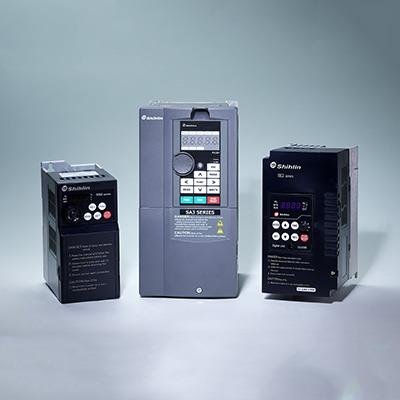Shilin Inverter's four control methods for the motor
We often say Shilin Inverter controls motor equipment However, how is the control in detail? Originally, the inverter controls the motor, mainly based on the characteristic parameters of the motor and the motor operation request, and the control of the supply voltage, current, and frequency of the motor to the load is performed. There are four main methods commonly used in inverter control for motor control: U/f stability control, slip frequency control, vector control, and direct torque control.
1, U/f stability control U/f control is to change the motor power supply frequency to change the voltage of the motor power supply, so that the motor flux is fixed, in a wide speed range Inside, the power of the motor and the power factor are not reduced. Because it is the ratio of the voltage and the frequency, it is called U/f control. The primary problem with stable U/f control is that the low speed function is poor. When the speed is extremely low, the electromagnetic torque cannot overcome the large static friction force, and the torque compensation of the motor and the change of the custom load torque cannot be properly adjusted. Secondly, The actual speed of the motor cannot be precisely controlled. Because the constant U/f inverter is the open-loop control of the speed, the mechanical characteristic diagram of the asynchronous motor shows that the set value is the ideal idle speed of the stator frequency, and the actual speed of the motor is determined by the slip rate, so U The stability error of the /f stability control mode cannot be manipulated, so the actual rotational speed of the motor cannot be precisely controlled. 2. Slip Frequency Control The slip frequency is the difference frequency between the communication power frequency applied to the motor and the motor speed. According to the mathematical model of the asynchronous motor stability, when the frequency is mandatory, the electromagnetic torque of the asynchronous motor is proportional to the slip ratio, and the mechanical characteristic is a straight line. The slip frequency control is to manipulate the slip frequency to manipulate the torque and current. The slip frequency control needs to detect the speed of the motor to form a speed closed loop. The output of the speed regulator is the slip frequency, and then the sum of the motor speed and the slip frequency is used as the given frequency of the inverter. Compared with U/f control, its acceleration and deceleration characteristics and ability to restrain overcurrent are improved. In addition, it has a speed regulator, which uses a speed response to form a closed loop control, and the static error of the speed is small. However, to achieve steady-state control of the automatic control system, outstanding dynamic functions are not achieved. 3. Vector manipulation < vector="" manipulation,="" also="" called="" magnetic="" field="" oriented="" manipulation.="" it="" was="" first="" proposed="" by="" west="" german="" f.="" blasschke="" et="" al.="" in="" the="" early="" 1970s,="" and="" this="" principle="" was="" discussed="" in="" terms="" of="" dc="" motor="" and="" communication="" motor="" comparison.="" this="" led="" to="" the="" creation="" of="" a="" communication="" motor="" and="" equivalent="" dc="" motor.="" the="" vector="" control="" of="" the="" frequency="" conversion="" speed="" regulation="" is="" to="" connect="" the="" asynchronous="" motor="" in="" the="" three-phase="" coordinate="" system="" of="" the="" stator="" communication="" currents="" ia,="" ib,="" ic.="" after="" three-phase-two-phase="" change,="" the="" communication="" currents="" ia1="" and="" ib1="" in="" the="" two-phase="" stop="" coordinate="" system="" are="" equivalent,="" and="" then="" rotated="" and="" changed="" according="" to="" the="" rotor="" field="" direction,="" equivalent="" to="" the="" direct="" current="" im1,="" it1="" in="" the="" synchronous="" rotating="" coordinate="" system="" (im1="" is="" equivalent="" the="" excitation="" current="" of="" the="" dc="" motor;="" it1="" is="" equivalent="" to="" the="" armature="" current="" of="" the="" dc="" motor.="" then,="" according="" to="" the="" control="" method="" of="" the="" dc="" motor,="" the="" control="" amount="" of="" the="" dc="" motor="" is="" obtained,="" and="" the="" control="" of="" the="" asynchronous="" motor="" is="" completed="" after="" the="" corresponding="" coordinate="" reverse="" conversion.="" the="" emergence="" of="" the="" vector="" control="" method="" makes="" the="" asynchronous="" motor="" frequency="" conversion="" speed="" regulation="" in="" an="" all-round="" position="" in="" the="" motor="" speed="" regulation="" category.="" however,="" vector="" control="" skill="" requirements="" accurately="" estimate="" the="" motor="" parameters,="" and="" how="" to="" improve="" the="" accuracy="" of="" the="" parameters="" is="" a="" topic="" that="" has="" always="" been="" discussed.="" 4.="" direct="" torque="" control="" in="" 1985,="" professor="" depenbrock="" of="" ruhr="" university="" in="" germany="" first="" proposed="" the="" theory="" of="" direct="" torque="" control.="" this="" skill="" largely="" deals="" with="" the="" lack="" of="" vector="" manipulation.="" the="" current="" is="" controlled,="" and="" the="" flux="" linkage="" indirectly="" manipulates="" the="" torque.="" instead,="" the="" torque="" is="" directly="" manipulated="" as="" the="" controlled="" amount.="" the="" advantage="" of="" torque="" control="" is="" that="" the="" torque="" control="" is="" to="" control="" the="" stator="" flux="" linkage.="" in="" essence,="" the="" speed="" information="" is="" not="" required.="" the="" control="" is="" excellent="" in="" all="" the="" motor="" parameters="" except="" the="" stator="" resistance.="" the="" stator="" flux="" linkage="" observation="" is="" introduced.="" the="" device="" can="" easily="" calculate="" the="" synchronous="" speed="" information,="" so="" it="" can="" conveniently="" complete="" the="" speed="" sensorless.="" this="" kind="" of="" control="" is="" called="" speed="" sensorless="" direct="" torque="" control.="">


